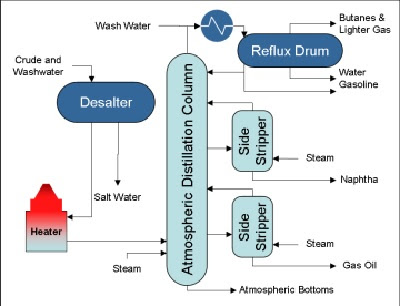Crude distillation unit (CDU) is a unit in an oil refinery where crude oil is heated and separated into different fractions based on their boiling points. The CDU is the first processing unit in most refineries and is responsible for producing the basic feedstocks for other refining processes.
Initial crude oil separation is accomplished by creating a temperature and pressure profile across a tower to enable different composition throughout the tower.
Crude distillation unit typically consists of a tall, cylindrical distillation column, a furnace, and a series of heat exchangers. The crude oil is pumped into the furnace and heated to a temperature of about 300°C (572°F). The hot oil is then fed into the distillation column, where it rises through a series of trays.
As the oil rises, the different fractions vaporize and condense on the trays. The lighter fractions, such as gasoline and kerosene, vaporize at lower temperatures and condense higher up in the column. The heavier fractions, such as diesel oil and fuel oil, vaporize at higher temperatures and condense lower in the column.
Desalted crude oil is preheated to a temperature of 500-550˚F (260-290˚C) through heat exchange with distillation products, internal recycle streams and tower bottoms liquid. Finally, the crude oil is heated to approximately 750˚F (400˚C) in a fired heater and fed to the atmospheric distillation tower.
Crude distillation unit
Distillation concentrates lower boiling point material in the top of the distillation tower and higher boiling point material in the bottom. Progressively higher boiling point material is present between the top and bottom of the tower. Heat is added to the bottom of the tower using a reboiler that vaporizes part of the tower bottom liquid and returns it to the tower.
Heat is removed from the top of the tower through an overhead condenser. A portion of the condensed liquid is returned to the tower as reflux. The continuous vaporization and condensation of material on each tray of the fractionation tower is what creates the separation of petroleum products within the tower.
The most common products of atmospheric distillation are fuel gas, naphtha, kerosene (including jet fuel), diesel fuel, gas oil and resid. Atmospheric distillation units run at a pressure slightly above atmospheric in the overhead accumulator.
Temperatures above approximately 750˚F (400˚C) are avoided to prevent thermal cracking of crude oil into light gases and coke. With the exception of Coker units, the presence of coke in process units is undesirable because coke deposit fouls refining equipment and severely reduces process performance. You can also refer sulfur recovery unit, hydeocraking unit and VDC unit from here.
Products of a Crude distillation unit (CDU)
- Gasoline
- Kerosene
- Diesel oil
- Fuel oil
- Lubricants
- Waxes
- Asphalt
- Bitumen
